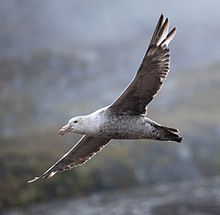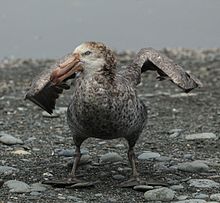- Northern Giant Petrel
-
Northern Giant Petrel 
Flying over Godthul, South Georgia, British Overseas Territories Conservation status Scientific classification Kingdom: Animalia Phylum: Chordata Class: Aves Order: Procellariiformes Family: Procellariidae Genus: Macronectes Species: M. halli Binomial name Macronectes halli
(Mathews, 1912)[2]The Northern Giant Petrel (Macronectes halli), also known as the Hall's Giant Petrel, is a large seabird of the southern oceans. Its distribution overlaps broadly with the similar Southern Giant Petrel, though it overall is centered slightly further north.
Contents
Taxonomy
The Northern Giant Petrel along with its counterpart, the Southern Giant Petrel, make up the Macronectes genus. They come from the Procellariiformes order, which are referred to as tube-nosed seabirds, due to their unique nose structure. All Tube-noses have tubular nostrils, and all Procellariidae have the openings on top of the upper portion of the bill. Procellariiformes also have between seven and nine distinct horny plates for their bill, and Petrels have one of these plates that form the hooked portion of their upper bill called their maxillary unguis. They produce a stomach oil made up of wax esters and triglycerides that is stored in the proventriculus. This is used against predators as well as an energy rich food source for chicks and for the adults during their long flights.[3] Finally, they also have a salt gland that is situated above the nasal passage and helps desalinate their bodies, due to the high amount of ocean water that they imbibe. It excretes a concentrated saline solution from their nostrils.[4]
Etymology
Macronectes giganteus can be broken down as makros a Greek word meaning long or large and nēktēs meaning swimmer. Northern Giant Petrel starts with northern referring to their habitat being further north than their counterpart the Southern Giant Petrel, and Petrel refers to Saint Peter and from the story of him walking on water, which refers to how they run on top of the water as they are getting airborne.[5]
Description
The Northern Giant Petrel averages 90 cm (35 in) in length. Its plumage consists of grey-brown body with lighter coloured forehead, sides of face, and chin. Its bill is between 90–105 mm (3.5–4.1 in) long and is pinkish yellow with a brown tip, and its eyes are grey. The juvenile of this species is completely dark brown and lightens as it ages. It can be differentiated from the similar coloured Southern Giant Petrel by the top of the bill, which on the southern is green.[1]
Behaviour
Feeding
The Northern Giant Petrel feeds mainly on carrion from penguins and pinniped, as well as krill, offal, cephalopods, and discarded fish and waste from ships. During breeding season, males eat more carrion than females with the females feeding on pelagic sources.[1]
Breeding
Birds start breeding on average of ten years of age, and breed on islands in colonies. Where they share islands with the Southern Giant Petrel, they breed six weeks earlier than their counterpart.[1]
Range and habitat
They are pelagic and fly throughout the southern oceans north of the Antarctic Convergence Zone, and north through Chile, Argentina, South Africa, and half of Australia. They nest on islands with the South Georgia group with 4,500 pair. They also nest on some of the Chatham Islands, Kerguelen Islands, Crozet Islands, Macquarie Island and others. Their overall occurrence range is 82,600,000 km2 (31,900,000 sq mi).[1]
Conservation
Breeding Population and Trends[1] Location Population Date Trend South Georgia 4,500 pair 2005 Increasing 30% per 20 yr Forty-Fours 2,000 pair 2000 Middle Sister 80—100 pair 2000 Kerguelen Islands 1,450—1,800 pair 1989 Crozet Islands 1,300 pair 1989 Decreasing Macquarie Island 1,300 pair Stable or Increasing Prince Edward Islands 650 pair Increasing Antipodes Island 230 pair 2003 Campbell Island 230 pair 2000 Auckland Islands 50 pair 2000 Total 17,000—21,000 2001 Increasing 34% per 10 yr Overall their population stands at between 17,000 and 21,000 mature birds, based on a 2001 estimate. This number has been increasing over the last two decades even though it was forecast to decrease. This increase has allowed the IUCN to downgrade them from Near Threatened to Least Concern. Recent surveys have shown that most locations are increasing in numbers except for Crozet Islands. This is probably due to increases in fish waste, better control on longline fishing, and more carrion from Fur Seals.[1]
Currently this bird is listed on CMS Appendix II and ACAP Annex 1. Future plans are to maintain the surveys and counting of individuals, researching movement and migrations, continuing the trend of lowering the bycatch deaths by current means and if needed newer measures through CCAMLR, CMS, and FAO.[1]
Footnotes
References
- BirdLife International (2009). "Northern Giant-petrel - BirdLife Species Factsheet". Data Zone. http://www.birdlife.org/datazone/species/index.html?action=SpcHTMDetails.asp&sid=3871&m=0. Retrieved 17 Jul 2009.
- "The BirdLife checklist of the birds of the world, with conservation status and taxonomic sources." (xls). 2009(a). http://www.birdlife.org/datazone/species/downloads/Checklist_v2_June09.zip. Retrieved 17 Jul 2009.
- Brooke, M. (2004). "Procellariidae". Albatrosses And Petrels Across The World. Oxford, UK: Oxford University Press. ISBN 0-19-850125-0.
- Double, M. C. (2003). "Procellariiformes (Tubenosed Seabirds)". In Hutchins, Michael; Jackson, Jerome A.; Bock, Walter J. et al.. Grzimek's Animal Life Encyclopedia. 8 Birds I Tinamous and Ratites to Hoatzins. Joseph E. Trumpey, Chief Scientific Illustrator (2 ed.). Farmington Hills, MI: Gale Group. pp. 107–111. ISBN 0 7876 5784 0.
- Ehrlich, Paul R.; Dobkin, David, S.; Wheye, Darryl (1988). The Birders Handbook (First ed.). New York, NY: Simon & Schuster. pp. 29–31. ISBN 0 671 65989 8.
- Gotch, A. F. (1995) [1979]. "Albatrosses, Fulmars, Shearwaters, and Petrels". Latin Names Explained A Guide to the Scientific Classifications of Reptiles, Birds & Mammals. New York, NY: Facts on File. p. 190. ISBN 0 8160 3377 3.
External links
Categories:- IUCN Red List least concern species
- Procellariidae
- Birds of South Australia
- Birds of Tasmania
- Birds of South Georgia and the South Sandwich Islands
- Animals described in 1912
- Fauna of the Prince Edward Islands
- Fauna of Macquarie Island
Wikimedia Foundation. 2010.



